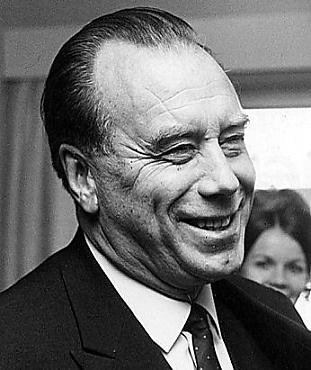
Urho Kaleva Kekkonen, often referred to by his initials UKK, was a Finnish politician who served as the eighth and longest-serving president of Finland from 1956 to 1982. He also served as prime minister, and held various other cabinet positions. He was the third and most recent president from the Agrarian League/Centre Party. Head of state for nearly 26 years, he dominated Finnish politics for 31 years overall. Holding a large amount of power, he won his later elections with little opposition and has often been classified as an autocrat. Nevertheless, he remains a respected figure.

Mauno Henrik Koivisto was a Finnish politician who served as the ninth president of Finland from 1982 to 1994. He also served as the country's prime minister twice, from 1968 to 1970 and again from 1979 to 1982. He was also the first member of the Social Democratic Party to be elected as President of Finland.

Väinö Alfred Tanner was a leading figure in the Social Democratic Party of Finland, and a pioneer and leader of the cooperative movement in Finland. He was Prime Minister of Finland in 1926–1927.

Johannes Virolainen was a Finnish politician and who served as 30th Prime Minister of Finland, helped inhabitants of Karelia and created Mandatory Swedish in Finnish basic schools.

Karl-August Fagerholm was a Finnish politician. Fagerholm served as Speaker of Parliament and three times Prime Minister of Finland. Fagerholm became one of the leading politicians of the Social Democrats after the armistice in the Continuation War. As a Scandinavia-oriented Swedish-speaking Finn, he was believed to be more to the taste of the Soviet Union's leadership than his predecessor, Väinö Tanner. Fagerholm's postwar career was, however, marked by fierce opposition from both the Soviet Union and the Communist Party of Finland. He narrowly lost the presidential election to Urho Kekkonen in 1956.

Keijo Antero Liinamaa was a Finnish lawyer and politician who served as caretaker Prime Minister of Finland from June to November 1975.

Ahti Kalle Samuli Karjalainen was a Finnish economist and politician. He was a member of the Agrarian League and served two terms as Prime Minister of Finland. He is, however, better known for his period as Minister of Foreign Affairs of Finland. Karjalainen is considered one of the most influential figures in post-war Finnish politics. Like President Urho Kekkonen, Karjalainen attached great importance to Finland's relationship with the Soviet Union, and was at one point considered to be Kekkonen's likely successor until alcoholism affected his later career.

Kustaa Rafael Paasio, born Hellström was a prominent Finnish politician and editor from Social Democratic Party. He served as Prime Minister of Finland twice.

Sakari Severi Tuomioja was a Finnish politician and diplomat who served as Prime Minister of Finland between 1953–1954 and as Minister for Foreign Affairs between 1951–1952 and as the Governor of the Bank of Finland between 1945–1955. He was also Finland's ambassador in London and Stockholm.

Parliamentary elections were held in Finland on 17 and 18 March 1945. The broad-based centre-left government of Prime Minister Juho Kusti Paasikivi remained in office after the elections.
Parliamentary elections were held in Finland on 6 and 7 July 1958. The communist Finnish People's Democratic League emerged as the largest party, but was unable to form a government.
Parliamentary elections were held in Finland on 1 and 2 July 1948.
Parliamentary elections were held in Finland on 20 and 21 March 1966. The Social Democratic Party (SDP) overtook the Centre Party as the largest faction in Parliament. Rafael Paasio of the SDP subsequently became Prime Minister and formed a popular front government consisting of the SDP, the Centre Party, the People's Democratic League (SKDL), and the Social Democratic Union of Workers and Smallholders (TPSL) in May 1966.
Tammi, also known as Kustannusyhtiö Tammi and Tammi Publishers, is a Finnish publishing company established in 1943 by an initiative of Väinö Tanner, leader of the Social Democratic Party of Finland. In 1996, the company was bought by the Bonnier Group, and, as of the early 2000s, it was the third largest book publisher in Finland. In 2018, the company was merged into the Finnish book publishing company Werner Söderström Osakeyhtiö (WSOY). Tammi was formerly known as Kustannusosakeyhtiö Tammi.
Social Democratic Union of Workers and Smallholders was a political party in Finland. TPSL originated as a fraction of the Social Democratic Party of Finland, headed by Emil Skog and Aarre Simonen. Skog was the former chairman of SDP and was in dispute with the incumbent chairman, Väinö Leskinen. The party was founded in 1959, had seats in the parliament in 1959–1970 and was dissolved in 1973. It was generally identified as being politically between SDP and SKDL.

Väinö Olavi Leskinen was a Finnish politician, minister and a member of the parliament from Social Democratic Party of Finland. He is perceived as one of the major Finnish social democratic politicians of the 1950s and 1960s.

Yrjö Kaarlo Leino was a Finnish communist politician. Imprisoned twice for his communist activities, and spending much of the Second World War as an underground communist activist, he served as a minister in three cabinets between 1944 and 1948.

The Social Democratic Party of Finland is a social democratic political party in Finland. It is the third largest party in the Parliament of Finland with 43 seats.

Eero Aarne Wuori was a Finnish journalist and politician.

The Night Frost Crisis or the Night Frost was a political crisis that occurred in Soviet–Finnish relations in the autumn of 1958. It arose from Soviet dissatisfaction with Finnish domestic policy and in particular with the composition of the third government to be formed under Prime Minister Karl-August Fagerholm. As a result of the crisis, the Soviet Union withdrew its ambassador from Helsinki and put pressure on the Finnish government to resign. The crisis was given its name by Nikita Khrushchev, who declared that relations between the countries had become subject to a "night frost".





























